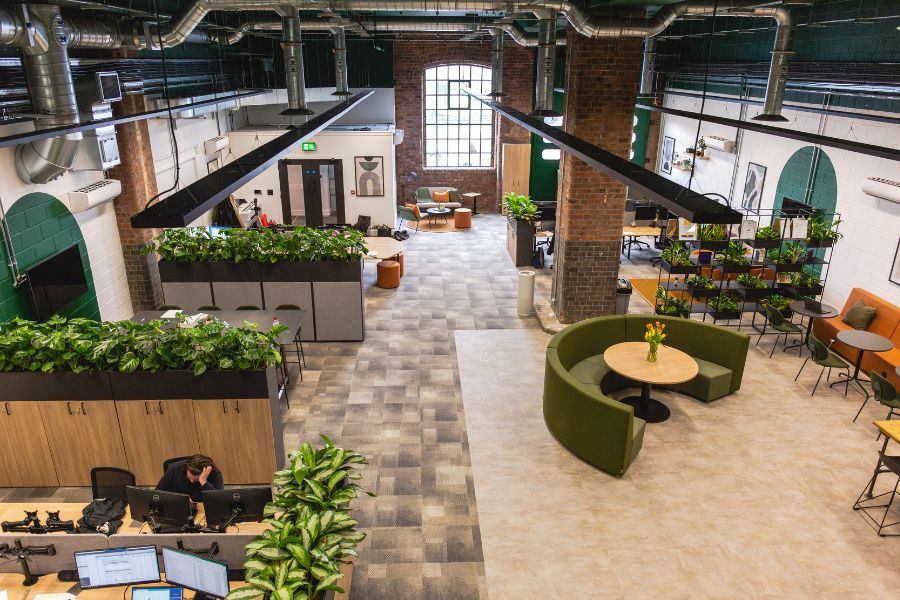Agile working is a modern concept where employers actively encourage employees to operate where, when and how they choose through empowering more choice and control.
Agile working is similar to flexible working. However, there are some key differences between the two.
Flexible working is primarily motivated by employee convenience and covers more HR-related areas like working hours, working location and more interchangeable roles.
Agile working, on the other hand, is a strategy used by employers to achieve short and long-term business goals by optimising the employee experience. Agile working also encompasses working location (i.e. remote work) and how employees use the physical working environment (i.e. the office).
The benefits of agile working
From improving communication between staff to giving employees the choice and control they need to feel motivated and included, there are many pros of implementing an agile working model.
Below, we explore some of the key benefits of agile working including:
- Maximising your office space and how it is designed.
- Creating a more diverse choice of work settings and more autonomy for employees.
- Fostering a culture of trust and transparency.
Maximises office design
After salaries, it’s likely that the rent or mortgage on your building is one of your company’s largest overheads. So, why not make your space work harder? Especially if you work in a small space or you’re thinking about downsizing your office.
By making a few simple changes to your floor plans, you can ensure that each square foot of space is delivering a return on your investment.
For example:
If you have client-facing employees (e.g. salespeople) or part-time workers, at any given time several members of the team will likely be out of the office, on the road or meeting with customers elsewhere.
By opting for an agile workspace and installing a hot-desking solution instead of dedicated desks, you can significantly reduce the risk of their desks sitting empty while they’re out and about.
More diversity, more choice and control
Taking an agile approach to office design also frees up more space for additional work settings. Dedicated desks and one-purpose meeting rooms can be made more multifunctional so you can:
a) Make more of your workspace.
b) Provide employees with a more diverse ecosystem of work settings to choose from.
When people feel they can select work settings that support their task, personality or mood, they are going to be happier, healthier and as a result, more motivated, productive and loyal to your business.
Fosters a culture of trust, openness and transparency
By giving employees choice and control over where and when they work depending on their working requirements, it encourages a culture that is built on trust.
Giving people autonomy to manage their own working day shows that you respect them and care about how they feel in the workspace.
Successful companies are realising that it’s not always easy to measure a worker’s productivity based on the hours spent sitting at a desk.
Instead look at the quality of the work that is produced, the ideas that are generated and how engaged everyone is when working towards goals.
Agility doesn’t mean working less—in fact, more often than not, it enhances efficiency and performance.
Employees feel seen and heard
According to research by Mindspace, 25% of 18-24-year-olds are desperate for more breakout areas, while 23% want more space for private work and 19% want more creative brainstorming areas.
Facilitating the freedom of agile work tells employees that you are considering their needs.
Instead of telling them how they have to work and prescribing this through traditional office fit out and design, provide a versatile working environment that is inclusive of as many needs as possible instead.
Can agile working boost productivity?
Yes, agile working has been proven to enhance productivity in employees.
By providing a range of workspaces that are each designed with the type of work in mind, employees are able to select the most appropriate workspace for the task at hand.
When staff are able to choose the most appropriate setting to complete a varied range of tasks, they are more likely to perform to their best ability.
A sense of community and togetherness
If someone is working on a time-critical project that requires focus and concentration, sitting in an open-plan space could leave them feeling frustrated and unable to fully engage or cause them to seek quiet concentration at home.
If you provide employees with a range of workplace settings, they can easily transition from tasks without the need to leave their building, saving time, giving them the tools they need, and connecting them with their colleagues.
If the employee in the example above is provided with an acoustically-enhanced focus pod or a quiet zone where they can focus without distraction, productivity and wellbeing levels will naturally improve.
Agility with AV technology
Office technology has advanced greatly and now supports agile working as opposed to hindering it by tethering people to specific workstations.
Tech-integrated furniture now means people can plug in and connect in a whole host of different parts of the modern workplace.
This connected freedom of movement enables employees to work smarter and more efficiently.
Things to consider before implementing agile working
As you can see, there are many benefits to an agile working environment but there are a couple of things worth considering before you go full steam ahead into transforming your office…
The risk of working in isolation
When the term ‘agile working’ is used, often there is a common misconception that it simply means ‘working away from the office’ with a lot of employees working in isolation, with no real sense of belonging. However, this isn’t the case.
An agile working environment provides everything from collaborative and social spaces, to focus and rejuvenation spaces, bringing settings, people and technology together for maximum impact.
It also includes allowing employees the choice and control to work remotely if they feel this environment would best suit the task they’re working on.
That’s why it’s essential to use technology to your advantage—to ensure remote and resident workers are well-connected and can communicate seamlessly.
It requires a change of working culture
While implementing nomadic areas with hot desking solutions can be great for making the best use of your space, some employees can be reluctant to embrace change, and it can be difficult to break old habits.
By re-educating department managers, they will be able to effectively communicate to their teams why the changes are happening and the positive impact it will bring not only to the workspace, but people processes and ultimately, productivity.
Now you know more about why you should introduce a more agile working environment, read our expert tips on how to design an agile workspace.
Get in touch to speak to our experts about your next office transformation project or check out our case studies to get a feel for how we could support you too.










